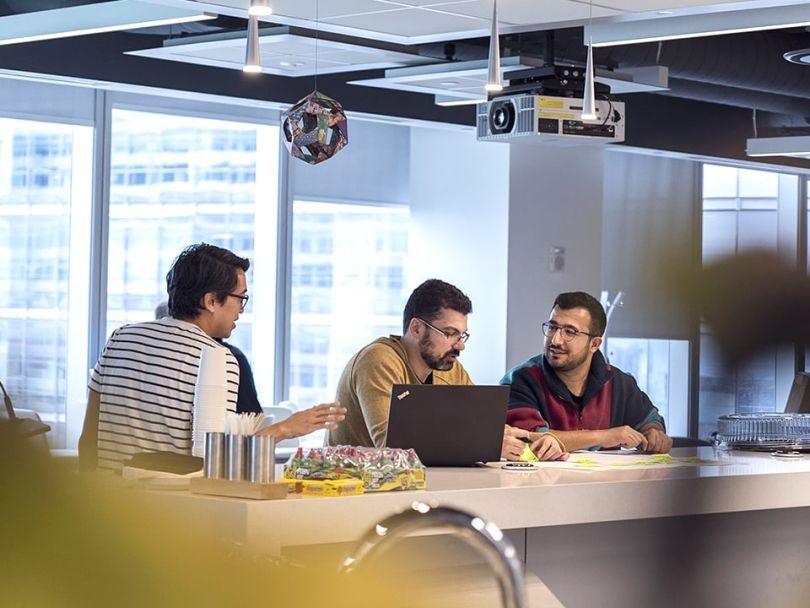Periods of high growth can be blessings for companies — but they’re not without the occasional pain point.
Fresh funds and talent no doubt can pave the way for conquering more ambitious roadmaps and reaching new audiences. With those accelerated efforts, though, can come the need to navigate new organizational nuances as the number of stakeholders, key players and customers balloons.
What’s more, as the resources at their disposal deepen, organizations must continue to focus on fostering innovation for the products and concepts around which they’ve gained traction.

For Hyperscience, it’s a timely topic to consider: After announcing an $80 million Series D in October (on the heels of a months-earlier Series C), the automation company finds itself expanding its scope and footprint in a big way.
“The collaboration required for large groups of people gets increasingly challenging as teams get bigger,” Francisco Uribe, VP of Product & Design at Hyperscience, said. “That’s why, as many organizations scale, they fail to scale their throughput linearly with their size.”
As VP of Engineering Suren Hiraman echoed, it’s crucial to retain the spirit of autonomy that often imbues an organization in its nascent days, while simultaneously cultivating “top-down alignment” on business goals to ensure clarity of direction.
“When you’re in that very early startup stage, that’s when you arguably have the most innovation, because everybody can move quickly,” Hiraman said. “You want to try to replicate that as much as possible within a growing organization.”
Of course, for an organization of any size, there’s no fail-safe formula for catalyzing original thinking and creative problem-solving. But there are some fundamental tenets to which the product, design and engineering duo at Hyperscience subscribe — Hiraman, for example, stressed the importance of “cross-functional ownership” as a bedrock for innovating.
“If you stay in your own lane, you may not present an idea that could be game-changing,” he said.
Recently, Uribe and Hiraman unpacked the ethos they embrace as they help power the next phase of the software company.
About the Tech
Historically, what philosophy has Hyperscience embraced in order to bring about innovative tech?
Hiraman: You have to have a safe-to-fail environment, where a willingness to take chances and calculated risks is rewarded. As long as you’re willing to learn from those experiences, then it’s worth taking chances. But if you fail, and you’re not willing to learn, you just repeat the same mistakes.
We have a fundamental company value: imaginative ideas come from everyone. Cross-functional ownership is key to innovation. If you stay in your own lane, you may not present an idea that could be game-changing. One of the best pieces of advice I ever got from a CTO was basically: violate the hierarchy. Great ideas come from everybody, so we need to be willing to cross those lines.
Uribe: We’re customer-obsessed and build backward from that. In general, as an organization scales, they tend to add layers between the product builders and the customers. A large sales force can inadvertently create barriers to understanding the customers’ wants and needs. We try to collect as much feedback as possible from our customers’ experiences, and, from there, build our product roadmap to meet their needs.
At the same time, we’re not accepting incremental improvements in how we deliver solutions to our customers. Life is short so we better spend our time wisely building something that’s high impact. Being bold in this “incremental is not enough” value is part of our team culture and paramount for success.
Great ideas come from everybody, so we need to be willing to cross those lines.”
The company is building the next generation of its platform with broader “input-to-outcome automation” capabilities. How does that reflect a commitment to innovative tech?
Uribe: Input-to-outcome is a natural transition for Hyperscience, leveraging our core strengths of state-of-the-art AI and proprietary human-in-the-loop tech. AI is not effective if it’s not human-centered. If our models aren’t able to perform on a specific document, but can be reviewed and corrected by humans, that correction helps us improve our machine learning models. Outcomes are the next step toward helping large organizations and government agencies not only process and analyze the intake of documents and data inputs in their workflows, but also to improve the quality of their end decisions.
For instance, think about processing a mortgage, which involves hundreds of documents. We help automate that process to enable humans to be more productive. By making information machine-readable, we can collate the data needed for an underwriter to make a higher-quality decision. Our systems are going to render better decisions at a micro-level. That’s at the heart of the input-to-outcome automation platform we’re building — and why we need people to join our team to help make this vision a reality!

How do you scale out product design and engineering operations without blunting innovation?
Hiraman: The process and operation side become very important. You can put too many processes in place, and that’ll cause you to slow down. A key for Hyperscience is that we function as one PDE organization. Operationally, we have a technical program manager role in both product and engineering, and they collaborate on shared operational health.
Also, it’s important to carefully choose metrics that help you understand the health of your organization. The wrong metrics can be misleading and lead to wrong decisions based on bad noise that’s hiding the true signal. It becomes very important to focus on delivery, quality and stability.
Uribe: In addition to being people-first, versus process-first, it’s important that we create a bottom-up culture. We organize our teams into bounded areas that have well-understood charters and contracts with each other and work to ensure that the teams themselves aren’t too large so that they can maintain cohesive collaboration and don’t have to deal with too much context-switching.
A sense of ownership is extremely important.”
What’s the collaborative nature between product design and engineering functions, and how does that provide a foundation for innovation?
Hiraman: Having a strong cross-functional squad as the foundation for ownership allows product, design and engineering to own that bounded area across different dimensions, like when we’re planning, designing, doing discovery and actually building things. We maintain that tight alignment through all the phases of the software development lifecycle. Having this shared sense of ownership over a specific domain means that everybody can understand the customer and everybody is bringing imaginative ideas from different perspectives.
Uribe: A sense of ownership is extremely important. It leads to people not thinking they only wear one hat, and instead, they’re partners in accomplishing the chapters of their bounded areas. They’re not just focusing on the work, but also how they’re doing their work. Then, we’re in this constant improvement mindset where we’re always giving each other feedback.
How would you encourage other leaders to foster innovation among their teams?
Hiraman: Celebrate the wins. Recognition and celebration makes it clear to everybody how their impact is valued. That, and the point that I made earlier: violate the hierarchy.
Uribe: It depends on the circumstances you’re in, but at Hyperscience, we’re extremely fortunate to be in the position we’re in with our recent fundraise to maximize our impact. Once you start looking at things from that perspective, there’s really no problem too large. We’re ambitious and believe there’s no challenge we can’t solve when we’re working together at our best. That mindset is very important.







